Chapter: 11th Geography : Chapter 7 : The Biosphere
Ecosystem and Major components of an ecosystem
Ecosystem
Organism
– includes animals,
plants and micro organisms.
Population
– is a group of
similar plants or animals living in an area.
Community
– refers to all the
plants and animals living in an area.
Ecosystem
– all living and
non living things and their interaction within an area.
Life cannot exist in isolation. It
flourishes in an environment which supplies and fulfills its material and
energy requirements. A biotic community and its physical environment in which
matter and energy flow and cycle is called as ecosystem.
The term ecosystem was first proposed by Arthur George
Tansley in 1935. Tansley defined ecosystem as, ‘the system resulting from the
integration of all living and non-living factors of the environment’. The
ecosystems can vary in size. It can be very small, extending to about a few
square centimeters or it can extend over many square kilometers. Example;
tropical forests.
Major components of an ecosystem
The ecosystem is made up of two main
components:
1.
Abiotic Component and
2.
Biotic Component
A.
Abiotic Component: This component of the ecosystem includes the non-living substance of the environment.
Example; light, air, soil, water, climate, minerals, etc. Sun is the main
source of energy for the earth.
B. Biotic
Component: This includes a variety of living organisms such as
microorganisms, plants and animals. The biotic component of an ecosystem can be
further divided into producers, consumers and decomposers based on their
capacity to sustain themselves (Figure 7.2).
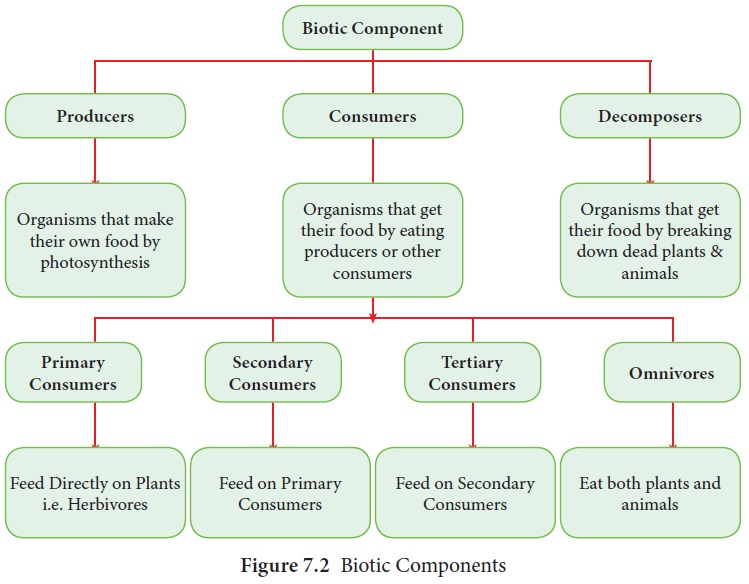
a. Producers: Organisms that can
produce or manufacture their own food are known as producers. Plants that have
green pigments or chlorophyll, produce their own food in the presence of CO2 in
the atmosphere, water from the soil and sunlight through a process called ‘photosynthesis’. These green plants are called as ‘autotrophs’ (auto – self; trophs – nourishing)
as they manufacture their own food.
b. Consumers: Consumers are
organisms that cannot manufacture their own food and get their food and
nutrients from producers directly or from other organisms. They are called as ‘heterotrophs’ (hetero – others; trophs –
nourshing).
Consumers can be divided into
primary, secondary and tertiary consumers.
1. Primary Consumers
Organisms that feed on producers (green plants) are called primary consumers. They are also called as ‘herbivores’ or plant eating organisms. Examples of terrestrial herbivore are grasshopper,sheep, goats, cow, rabbit, deer, elephant etc. Examples of aquatic herbivores are zoo plankton, krill, squid, small fish, sea urchin, etc.
2. Secondary Consumers
Animals that kill and eat the herbivores
or plant eating animals are called secondary consumers. They are also called as
‘carnivores’, Example; lion, tiger, foxes, frogs, snakes,
spider, crocodiles, etc.
3. Tertiary Consumers
They are top predators in a food
chain. They are carnivores at the topmost level in a food chain that feed on
other carnivores or secondary consumers. Example: an owl eats a snake but an
owl is eaten by a hawk, therefore a hawk is a tertiary consumer. Tertiary
consumers that occupy the top trophic level, and are not predated by any other
animals are called ‘apex predators’. However, when they die their bodies will be
consumed by scavengers besides the decomposers Example; alligator andhawk.
Some organisms eat both plants and
animals. These animals are called as‘omnivores. Example; cockroach, foxes, seagull and human.
Some omnivores are ‘scavengers’, which eat food that other animals
have left behind Example; hyena and vultures.
Plants and animals that live on or
inside other plants or animals are called as Parasites. Example; mistletoe lives on other plants. Other examples are tapeworms,
round worms, lice, ticks, flea etc.
‘Detritivores’ are consumers that feed on
detritus. Detritus includes fallen leaves, parts of dead trees and faecal
wastes of animals. Ants, termites, earthworms, millipedes, dung beetle, fiddler
crabs and sea cucumbers are detritivores.
4. Decomposers: Decomposers are organisms that help decompose dead or decaying organisms. Decomposers are also heterotrophs. Decomposers are nature’s built-in recycling system. By breaking down materials – decomposers return nutrients to the soil. They, in turn, create another food source for producers within the ecosystem. Mushrooms, yeast, mould, fungi and bacteria are common decomposers.
Food Chain and Food Web
Every living creature in an ecosystem
has a role to play. Without producers, the consumers and decomposers would not
survive because they would have no food to eat.
Without consumers, the populations of
producers and decomposers would grow out of control. And without decomposers,
dead producers and consumers would accumulate as wastes and pollute the
environment.
All organisms of an ecosystem depend
on one another for their survival. Each organism living in an ecosystem plays
an important role in the flow of energy within the system. Organisms need
energy for respiration, growth, locomotion, and reproduction. This movement of
energy is usually understood through food chains or food webs. While a food
chain shows one path along which energy can move through an ecosystem, food
webs show all the overlapping ways that organisms live with and depend upon one
another.
A. Food Chain
A food chain describes the flow of
food in an ecosystem. This flow or feeding structure in an ecosystem is called ‘trophic structure’. Each level in this structure is called a trophic level. A food chain
starts the movement of energy from one trophic level to the next (Figure 7.3).
Example; Plant (primary producer) is eaten by a rabbit (herbivores, primary
consumer), rabbit is eaten by a snake (carnivores, consumer or primary
carnivore)and the snake is eaten by a hawk (tertiary consumer).
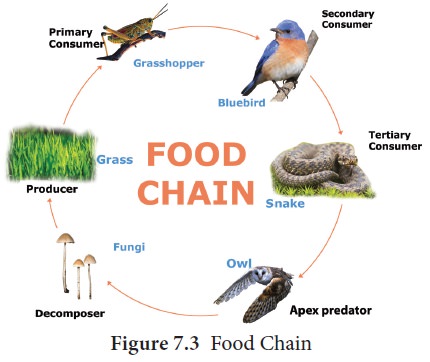
Food Web
A Food Web is a complex network of interconnected food chains. Food chains show a direct transfer of energy between organisms.
A chain might involve a mouse eating
some seeds on the forest floor, a snake eating the mouse and later an eagle
eating the snake.
With each step, some of the energy
from the sun, which is trapped within the seeds, is getting passed on.
In a food web, the mouse might eat
seeds, but it also might eat some grains, or maybe even some grass. The mouse
might be eaten by a snake, or the eagle, or even a fox. The snake could be
eaten by the eagle, but also might be eaten by a fox in the forest.
Since each organism can eat multiple
organisms and be eaten by multiple organisms, a food web is a much more
realistic scheme of the transfer of energy within an ecosystem (Figure 7.4).
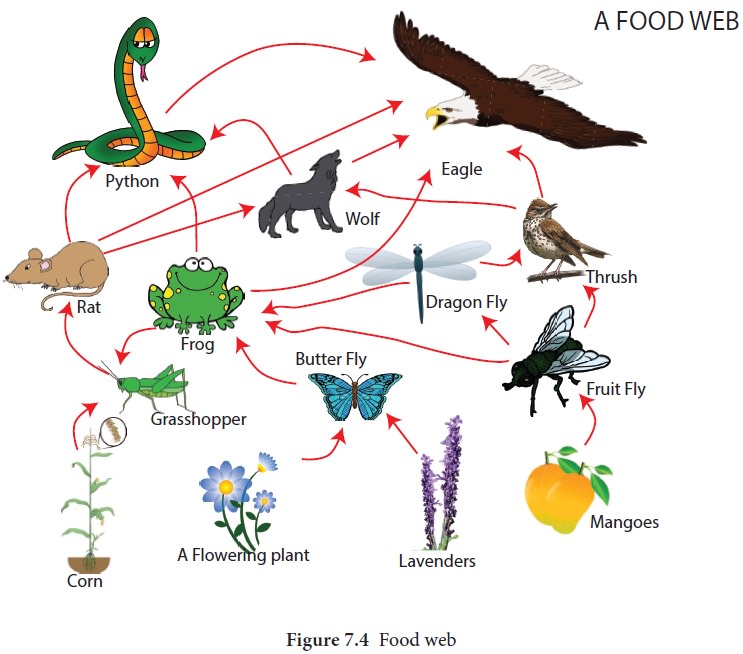
Food chains and food webs are found
in both terrestrial and aquatic ecosystems.
Organisms in a food chain or food web
are linked and dependent on one another for survival. If organisms in one
trophic level become threatened, it impacts the organisms in other trophic
levels. Primary consumers get less food due to loss or destruction of habitat.
This in turn means less primary consumers for secondary and tertiary consumers to feed on.
The plant and
animal species in such an environment could become endangered or even extinct.
For this reason, it is vital that an ecosystem remains balanced containing an
appropriate proportion of producers and consumers.
Energy Flow in an Ecosystem
Energy in an ecosystem flows from producers to consumers. The available energy in a food chain decreases with each step or trophic levels up in the food chain. As such, there is less energy available to support organisms at the top of the food chain. That is why the tertiary and quaternary consumers are far less in number in an ecosystem than organisms at lower trophic levels.
Energy Pyramids
Energy pyramids are another tool that
ecologists use to understand the role of organisms within an ecosystem. As you
can see, most of the energy in an ecosystem is available at the producer level.
As you move up on the pyramid, the amount of available energy decreases
significantly. It is estimated that only about 10% of the energy available at
one trophic level gets transferred to the next level of the energy pyramid. The
remaining 90 percent of energy is either utilized by the organisms within that
level for respiration and other metabolic activities or lost to the environment
as heat.
The energy pyramid shows how
ecosystems naturally limit the number of each type of organism it can sustain
(Figure 7.5).
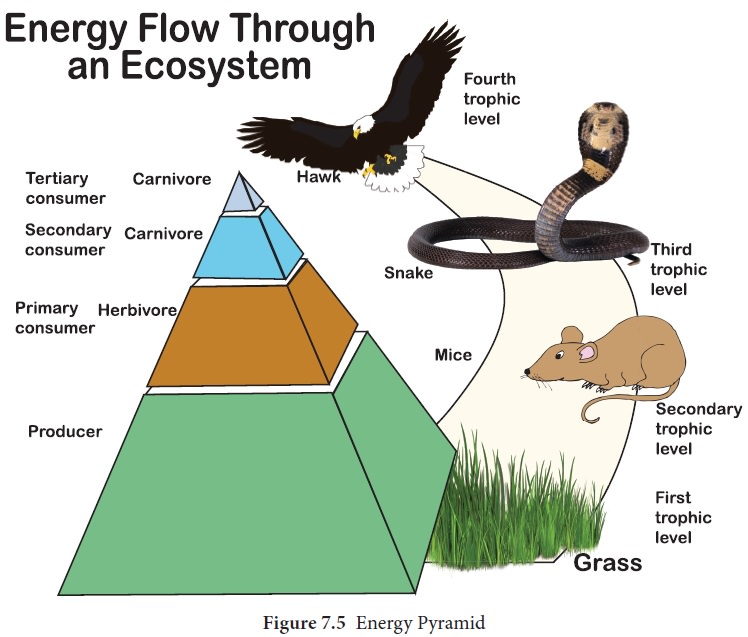
Cycles in an Ecosystem
Nutrients move through the ecosystem
in cycles is called ‘biogeochemical cycles’. A biogeochemical cycle is a circuit or pathway by
which a chemical element moves through the biotic and the abiotic components of
an ecosystem. All life processes are associated with the atmosphere by
important cycles such as the Carbon, Oxygen, Nitrogen cycles etc. Through these
cycles energy and materials are transferred, stored and released into various
ecosystems. Let us discuss one of biogeochemical cycles in detail - the Carbon
cycle.
The Carbon Cycle
Carbon is exchanged, or cycled among
all the spheres of the earth. All living organisms are built of carbon
compounds. It is the fundamental building block of life and an important
component of many chemical processes. Living things need carbon to live, grow
and reproduce. Carbon is a finite resource that cycles through the earth in
many forms.
Carbon is an essential element in all
organic compounds and since there is only a limited amount available it must be
recycled continuously. This takes place in the biosphere. Atmospheric carbon is
fixed in green plants through photosynthesis.
This carbon is passed on to other
living organisms through the food chain. The carbon food compound is utilized
and later released to the atmosphere through the process of respiration.
By-products of respiration are
carbon-dioxide and water which are returned to the air.
A carbon cycle is completed by decomposers like bacteria and fungi which break down dead plants and animal tissues there by releasing some carbon to the air, water and soil.
All producers and consumers are not
decomposed. The organic matter of some of them is preserved in fossil fuels
such as coal and petroleum for millions of years.
In a carbon cycle (Figure 7.6),
carbon moves between reservoirs. Carbon reservoirs include the atmosphere, the
oceans, vegetation, rocks, and soil.
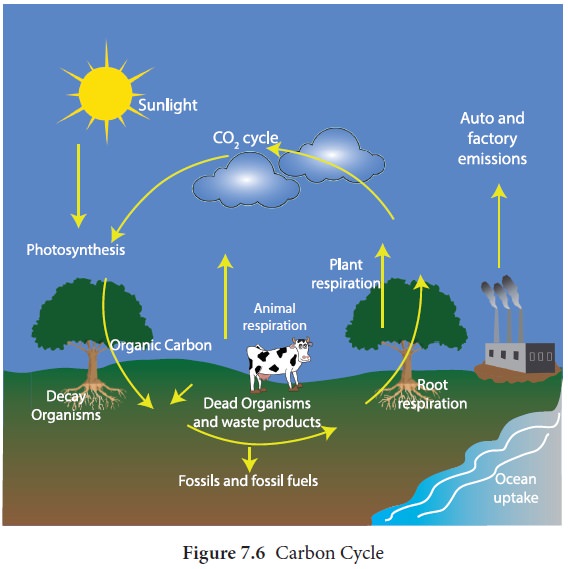
Today, the carbon cycle is changing.
Human activities have added more carbon into the atmosphere. More carbon is
moving to the atmosphere when fossil fuels, like coal and oil, are burned. More
carbon is moving to the atmosphere as humans destroy the forest. This increase
in carbon in the atmosphere causes the earth to warm up more than the normal
level, leading to climate change and many problems connected with it.
Related Topics